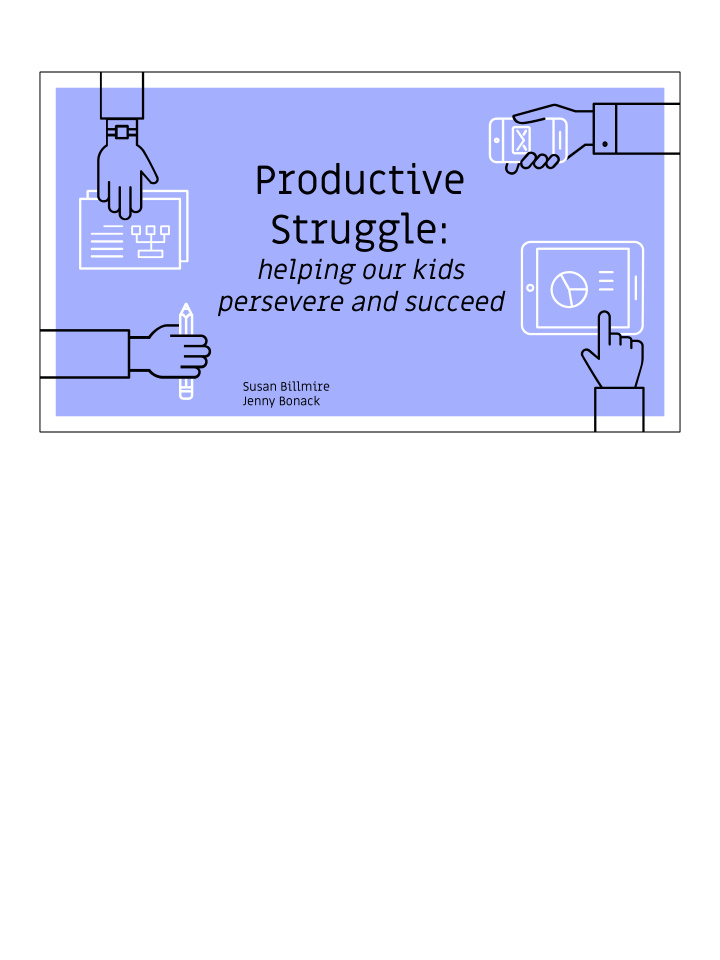



Productive Struggle: helping our kids persevere and succeed Susan Billmire Jenny Bonack
Padlet.com https://bit.ly/2OoQLXb What did you What things hear on the do you hear at video that is home from 2 different your child from what about school? you hear at home? Youtube link: https://www.youtube.com/watch?v=RgvwprZtQjw Padlet information is still posted: You can click link and view responses. Password is AGMS
Turn and Talk What do you see on the padlet that resonates? 3 What is familiar? When struggle happens at your house, what happens next? What you’re experiencing is normal--at some point all students should struggle.
Perception Reality What would you tell Middle School is not your 7th grade self? like it was before. We know so much What do you picture more about brain when you picture 4 development than middle school? when we were in middle school. Technology influences our kids positively and negatively. Brain development makes their perception skewed. 7th Graders are: Self absorbed, impulsive, argumentative, testing boundaries, looking for an identity and a group Technology plays a huge part in identity, in social groupings, in their decision making Your child is not the only child who cries at school.
Today’s workforce is looking for problem solvers, people who work well together and who know how to use their resources. 5
Middle School 6 From 6th-7th-8th grade and beyond
The Dependent Learner The Independent Learner ∙ ∙ Is dependent on the teacher Relies on the teacher to carry to carry most of the cognitive some of the cognitive load load of a task always temporarily ∙ ∙ Is unsure of how to tackle a Utilizes strategies and new task processes for tackling a new ∙ Cannot complete a task task ∙ without scaffolds Regularly attempts new tasks 7 ∙ Will sit passively and wait if without scaffolds ∙ stuck until teacher intervenes Has cognitive strategies for ∙ Doesn’t retain information getting unstuck ∙ well or “doesn’t get it” Has learned how to retrieve information from long-term memory Not an overnight switch. The transition from elementary school and 6th grade, to 7th grade, continues to progress until kids are prepared for 8th grade, high school and beyond. We are equipping them and guiding them to be independent learners, not expecting perfection right now Our long term goal is productive, efficient citizens, not good test takers
How do teachers move students towards independence? ▹ Note taking and examples/ exemplars ▹ Guided notes 8 ▹ Peer Editing ▹ Coaching on Executive Functioning: agendas, organization, reflection ▹ Support Stations ▹ Homework Room ▹ Before School Help These are all examples of things that happen/exist in 7th grade classrooms at AG. Ask your child if they can tell you about any of them
How can parents help students move towards independence? ▹ Teach your child how to email the teacher ▹ Show your student how to review 9 notes and study from them ▹ Share a calendar to plan out big projects ▹ Point out when something works ▹ Check in but don’t hold the pen ▹ Monitor study skills (distractions, computer usage, phone usage,etc.) Share on the padlet other strategies that work for your household Padlet link: https://padlet.com/jennifer_bonack/ifhwx3b1kmof Link is still live. Click to view responses.
Brain Development In Adolescents Limbic System is the area in the brain that controls emotions and this is developed before the Prefrontal Cortex. The Prefrontal Cortex is responsible for planning, rationality, and logical thinking. 10 Synapse , also called neuronal junction, the site of transmission of electric nerve impulses between two nerve cells (neurons) or between a neuron and a gland or muscle cell. This creates pathways in the brain. We learn more when we make mistakes and can relate our learning back to a feeling good or bad). Kids need to be in there feelings but how do we handle our kids when they are emotional is really important.
What to do in the moment of breakdowns? Give them love but give them space to regain control 11 Avoid blame Model good coping skills Console Them Validate their feelings Call it a night for homework/wake up early What to do when a breakdown/freakout happens Take a time out yourself Focus on one issue, don’t drag others in Breath, take a walk, take a break--HORSE, wall ball, switch subjects, play a game of cards or a board game After calm descends (may even be a few days later) identify and name the behavior or response (example: It is ok for you to be upset, it is not ok for you to say hurtful things to us when you are upset) Help identify a more productive response, or a trigger to look for (physical responses, emotions escalating)
Window of Opportunity for Influencing ▹ Discuss the “episode” and boundaries 12 ▹ Reach out to teachers to see how your child uses their time and opportunities ▹ Remind your child of the goal (learning to study, becoming an independent learner) Help your child process through why they had a meltdown and what triggered it--what did they feel before, during, after Use indirect conversation--during car rides, while playing a game, etc. Normalize this process as well--get your child used to thinking through their actions (both positive and negative)
It is not what you do for your children, but what you have taught them to do for themselves that will make them successful human beings. --Ann Landers 13
Recommend
More recommend